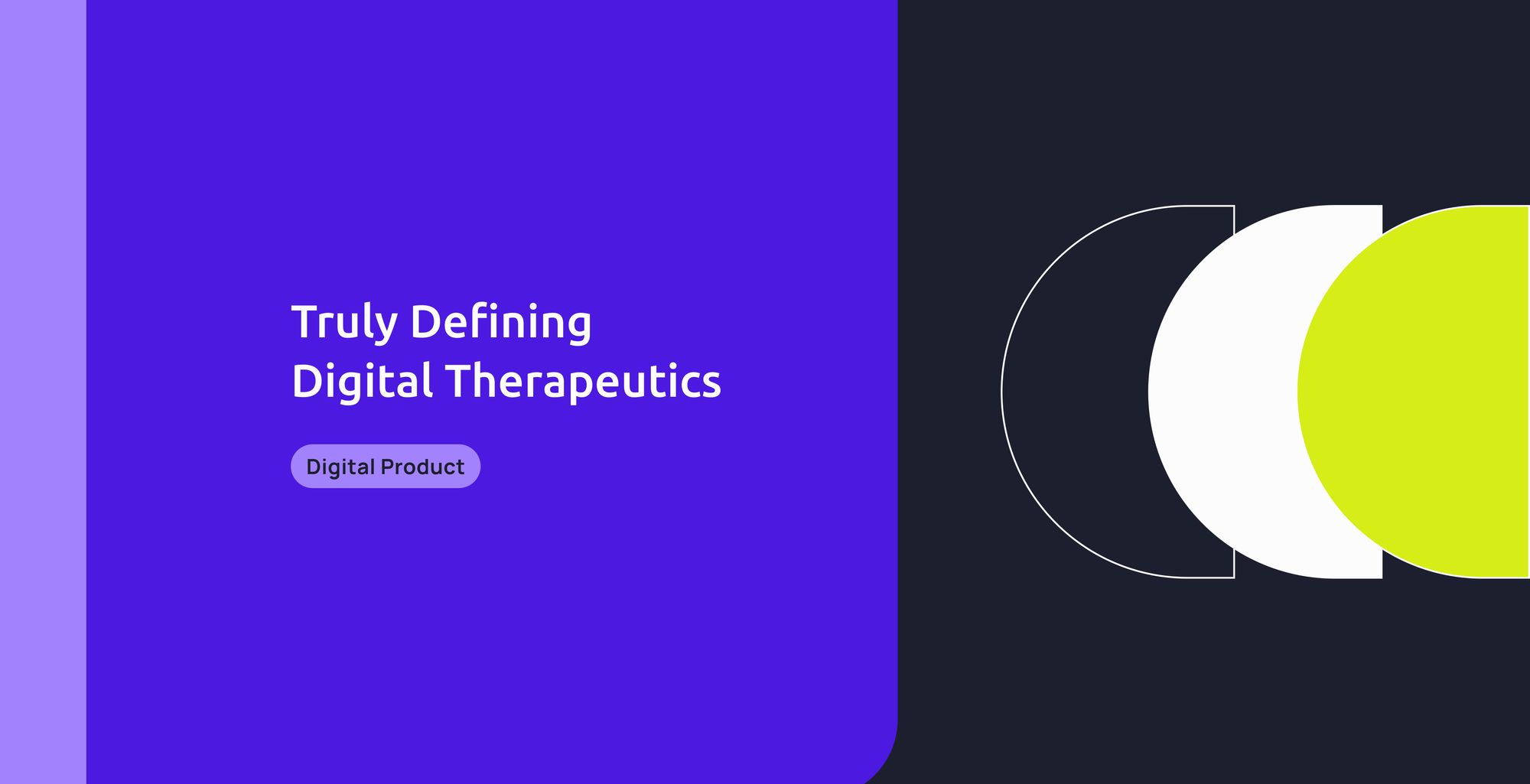Digital Therapeutics is trending in healthcare
According to Saurabh Gupta, Innovation Research and Strategy expert at Netscribes (a global data and insights firm), the Digital Therapeutics field has received an immense boost because of the COVID-19 pandemic, and it continues to help medical professionals redefine their outlook on care delivery. Additionally, it plays a pivotal role in enhancing clinical pathways.
Let's start from the beginning!
What is Digital Therapeutics referred to?
They are evidence-based therapeutic interventions driven by software programs that prevent, manage, and treat diseases or medical disorders, as the Digital Therapeutics Alliance (the leading global authority on the evolution of digital health technology) defines it. For instance, these therapies have intervened heavily in preventing diabetes and obesity. Connected digital health devices like insulin pumps, blood glucose meters, and other wearable devices can all send data to a unified system. Self-reported information on aspects like diet and others is also used in the therapy.
According to the FDA, these DTx products can be classified into different categories. On a broader sense, there are:
- Medical device
- Software as a Medical Device (SaMD)
- Clinical Decision Support Software (CDS)
- Patient Engagement and Support tools
- Disease Management or Treatment Support
In a more segmented category, there are:
- Personalized Treatment Algorithms
- Digital Diagnostics
- Remote Monitoring and Wearable Devices
- Therapeutic Games or Cognitive Training
- Genomic Health Tools
- Telemedicine Platforms (While not strictly a DTx category, telemedicine platforms that facilitate remote medical consultations and examinations might need to comply with the FDA.)
It's important to remember that although these products aim to improve health outcomes, they are not entirely meant to replace conventional medical treatments. Their role complements existing medical care, presenting additional avenues for patients to manage their health conditions.
Digital Therapeutics examples:
Knowing that these DTx products are software that delivers a therapeutic intervention that treats a medical disease, manages a disease, or improves a health function, where exactly can we find them? They can be used across a wide range of medical conditions, including:
- Mental Health Apps: Apps designed to help manage anxiety, depression, stress, or other mental health conditions through cognitive behavioral therapy (CBT) exercises, mindfulness practices, and mood tracking.
- Diabetes Management Platforms: Digital tools that assist individuals with diabetes in tracking their blood sugar levels, medication schedules, and lifestyle factors like diet and exercise.
- Smoking Cessation Programs: Apps that offer personalized plans, progress tracking, and support to help individuals quit smoking.
- Sleep Improvement Apps: Apps that provide strategies for improving sleep hygiene and monitoring sleep patterns.
- Weight Management Solutions: Digital platforms that offer personalized diet and exercise plans, calorie tracking, and motivational support for weight loss and maintenance.
- Cardiovascular Health Apps: Apps that help users manage hypertension or other cardiovascular conditions by monitoring blood pressure, providing medication reminders, and encouraging lifestyle changes.Chronic Pain Management Tools: Digital interventions that offer pain relief through exercises, mindfulness techniques, and education about pain management strategies.
What are the elements you must take into account when building a DTx product?
- If you are building a DTx product, you must check its clinical validity. In a nutshell, the DTx product must be based on strong scientific evidence and clinically validated through rigorous testing and clinical trials to demonstrate its effectiveness in treating or managing a specific health condition. Here, it's crucial to prioritize patient safety by identifying and mitigating potential risks associated with the product's use.
- When building a DTx product, you should understand and navigate the regulatory requirements for medical software in the regions where you plan to market your Digital Therapeutics product. In the United States, for example, this may involve the FDA's Digital Health Software Precertification (Pre-Cert) program, among others. Also, you must implement robust data protection measures to safeguard sensitive patient information during transmission and storage. Complying with data protection and privacy regulations like HIPAA (in the US) and GDPR (in Europe) is crucial to safeguard patient information.
- Another key point to consider when building a DTx product is the User Experience (UX) and User Interface (UI). The product should be intuitive and engaging to encourage user compliance, engagement, and long-term usage. How? Prioritizing a user-friendly and intuitive interface. You can personalize it or use gamification, incentives, and other strategies to keep users engaged and motivated to continue using the product. Also, remember that your DTx product must be accessible to users with disabilities, meeting WCAG (Web Content Accessibility Guidelines) standards.
4. Determine the involvement of healthcare professionals in your DTx product. For practitioners to have encounters, prescribe, and monitor patients, your DTx product might need to be integrated with their practice. This means it will be important for you to consider how your DTx product will integrate with existing healthcare systems and electronic health records (EHRs), facilitating communication between patients and providers. Ensuring this seamless data exchange coordination of care and that it complements existing treatments and therapies will make your product more effective and enhance patient outcomes and satisfaction.
5. Ensure your product is built in a scalable way, allowing it to easily accommodate a growing user base and to potentially expand into new markets. Design it to scale effectively as more users adopt it, ensuring the infrastructure can handle increased demand while maintaining optimal performance. Additionally, develop a long-term sustainability plan for your DTx product, encompassing regular updates, maintenance, and robust support services to ensure its continued success and relevance.
6. Promote continuous improvement by leveraging data analytics. Plan for ongoing data collection and analysis to continually gather evidence supporting your DTx product's effectiveness. Also, you should develop tools for analyzing collected data to refine treatment plans and enhance outcomes or implement mechanisms for ongoing product updates rooted in emerging clinical evidence.
How is the emergence of AI and technology helping to transform healthcare and Digital Therapeutics products?
The industry has changed significantly over the years, especially given the latest developments in Artificial Intelligence, and Digital Therapeutics was no exception to its transformative impact. Some ways in which AI is transforming healthcare and reshaping Digital Therapeutics (DTx) products are:
- AI-driven algorithms can analyze vast patient data to tailor treatments to individual needs. This personalization enhances the efficacy of DTx products, as treatments are more precisely matched to each patient's condition and preferences.
- Also, given the effectiveness of AI in detecting patterns and anomalies in patient data, it allows the early diagnosis of diseases and prediction of potential health issues. This proactive approach can lead to better management and outcomes, particularly in chronic conditions. This is really useful to have more efficient clinical trials as well.
- AI can accelerate the clinical trial process for DTx products by identifying suitable patient populations, optimizing trial designs, and streamlining data analysis. This efficiency accelerates the development and regulatory approval of new DTx solutions.
- Likewise, remote monitoring enables continuous tracking of patients' health, reducing the need for frequent in-person visits. This is particularly valuable for chronic disease management, post-operative care, and elderly patients, significantly improving accessibility and convenience.
- Moreover, technology is crucial in enhancing treatment compliance by employing AI-powered reminders and personalized recommendations, motivating users to adhere to their prescribed DTx programs for more successful outcomes.
- Finally, it empowers patients by granting them access to health information, monitoring tools, and educational resources, enabling informed decision-making and instilling greater control over their well-being.
Digital therapeutics (DTx) is significantly growing in healthcare. These evidence-based software-driven interventions are vital in preventing, managing, and treating various diseases, from mental health conditions to diabetes and chronic pain. Building successful DTx solutions demands clinical validation, regulatory adherence, user-friendly interfaces, and seamless integration with healthcare systems. AI and technology further enhance DTx by personalizing treatments, enabling early disease detection, and improving patient engagement, promising a transformative impact on healthcare delivery and patient outcomes.
If you want to join this revolution and make your digital Digital Therapeutics company thrive, contact us! We partner with healthcare niche companies to design and develop top-notch digital products, and we’ll be at Boston’s DTX Conference next September 26-28; let’s meet!
Whether it’s a doubt or an idea, we want to hear it!


